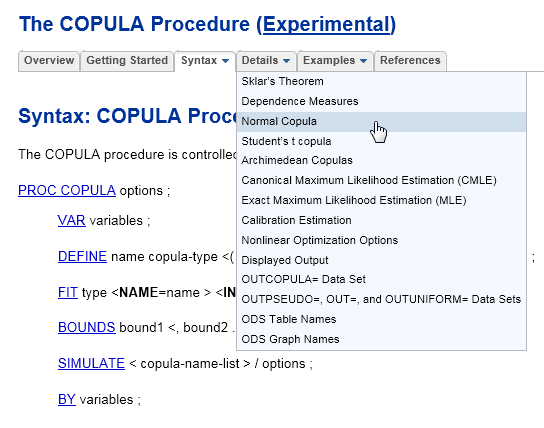Welcome, SAS 9.3! I've already blogged about some interface and graphical changes that everyone should know about. Now I'll put on my statistical hat and mention a few 9.3 features that excite me, personally, as a data analyst and a statistical programmer:
- As a statistician, I am keen to try the new FMM procedure, which fits finite mixture models. This regression procedure in SAS/STAT software should be useful when the response variable is a finite mixture of univariate distributions. You can also use it to model univariate data as a mixture of, say, three normal distributions. Sweet!
- As someone who runs a lot of simulations, I am eager to try the COPULA procedure in SAS/ETS software. The COPULA procedure enables you to simulate data from a multivariate distribution that has a given covariance structure. I've written a copula algorithm in SAS/IML, so I am looking forward to writing a "couple 'a" blog posts on comparing the two approaches. Plus, it's fun to say `kä-pyə-lə. Copula! Copula! Copula!
- As a statistical programmer, I am stoked about the new features in SAS/IML 9.3, such as the ability to call SAS procedures from within a SAS/IML program. (Technically, this feature has been available since SAS/IML 9.22, which shipped November, 2010.) In the fall, I intend to blog about the new SAS/IML features, but if you can't wait, you can browse the What's New in SAS/IML 9.3 document.
- I use the SAS/IML interface to the R language, and SAS/IML 9.3 enables me to call the most recent version of R. This corrects a problem that occurred when the R directory structure changed between R 2.11 and 2.12.
- Lastly, I use the SAS online documentation a lot while doing my SAS programming, so I was pleased to see several changes to the organization of the documentation.
- The large SAS Language Reference: Dictionary has been divided into seven documents. That should save me a few clicks.
- The main SAS Product Documentation page has been redesigned. If you know what you're looking for and which book it is in, click Find documentation for a specific product. Otherwise, there are new ways to search the documentation.
- The documentation for each procedure now has "tabs" that enable you to navigate directly to sections or subsections of the documentation. For example, the image at the end of this post shows the documentation page for PROC COPULA, and a drop-down menu that enables you to navigate within the "Details" section.
What is your favorite new statistical or SAS programming feature? Browse the What's New in SAS 9.3 document and let me know.


8 Comments
I am very interested in your future blog post comparing the new Copula procedure and the IML program.
Pingback: ODS Graphics: new features and bundling in SAS 9.3 - The SAS Dummy
Pingback: Modeling Finite Mixtures with the FMM Procedure - The DO Loop
Is sas9.3 able to do analysis in discrete discriminant statistics.
Tell me about Proc_Discrim.
Yes, PROC DISCRIM is an important tool for discriminant analysis. It has been around for many years, so if you do an internet search on "PROC DISCRIM" you will find many references. Or the SAS documentation contains an overview of the SAS discrimination procedures.
I am glad for your response, however, I am still worried if the SAS discriminant procedures could solve my problem in DISCRETE DISCRIMINANT analysis. And please direct me to obtain a copy of the software.
PROC DISCRIM assumes continuous data because it uses a distance metric as part of the analysis. For discrete discrimination, some people use PROC LOGISTIC or PROC LOGISTIC. Search for "log-linear models in SAS." Also see Butler 1998 for binary data.
You can find out more about ordering SAS software at http://www.sas.com/technologies/analytics/statistics/index.html
I find your response very helpful, having referred to Butler (1998).
Butler indicates that SAS procedures for nonparametric discriminant
analysis are introduced and analyzed for their use with discrete data, using
a combination of Base SAS and SAS/IML. How can I obtain this resource for
a student research work that I am carrying out?